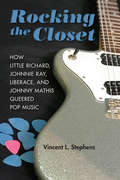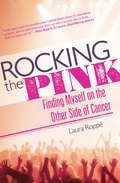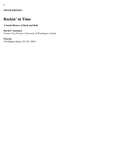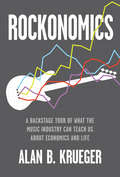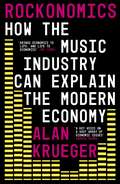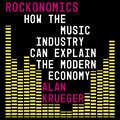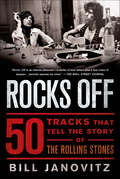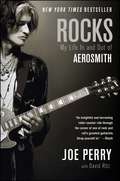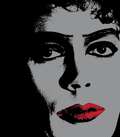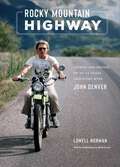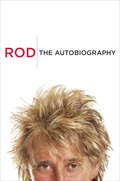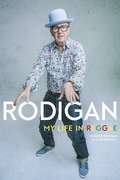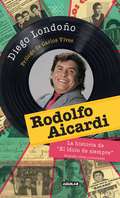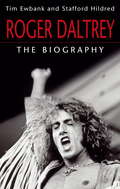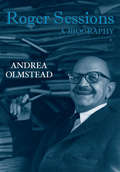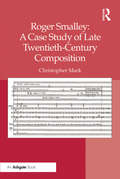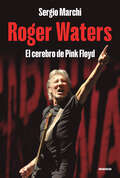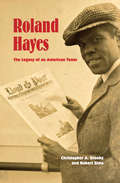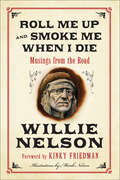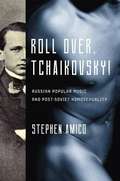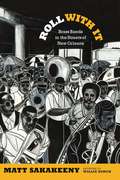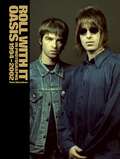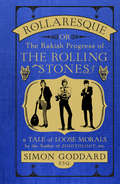- Table View
- List View
Rocking the Closet: How Little Richard, Johnnie Ray, Liberace, and Johnny Mathis Queered Pop Music (New Perspectives on Gender in Music #24)
by Vincent L StephensThe all-embracing, "whaddya got?" nature of rebellion in Fifties America included pop music's unlikely challenge to entrenched notions of masculinity. Within that upheaval, four prominent artists dared to behave in ways that let the public assume—but not see—their queerness. That these artists cultivated ambiguous sexual personas often reflected an understandable fear, but also a struggle to fulfill personal and professional expectations.Vincent L. Stephens confronts notions of the closet—both coming out and staying in—by analyzing the careers of Liberace, Johnny Mathis, Johnnie Ray, and Little Richard. Appealing to audiences hungry for novelty and exoticism, the four pop icons used performance and queering techniques that ran the gamut. Liberace's flamboyance shared a spectrum with Mathis's intimate sensitivity while Ray's overwrought displays as "Mr. Emotion" seemed worlds apart from Little Richard's raise-the-roof joyousness. As Stephens shows, the quartet not only thrived in an era of gray flannel manhood, they pioneered the ways generations of later musicians would consciously adopt sexual mystery as an appealing and proven route to success.
Rocking the Pink: Finding Myself on the Other Side of Cancer
by Laura RoppeIn 2008, just as Laura Roppé was poised to burst onto the music scene, her doctor called her with news that left her spinning—she had been diagnosed with an extremely aggressive form of breast cancer. Just days earlier, she had signed a dream-come-true contract with a record label; now, she wasn’t even sure how much longer she had to live. Never one to back down to a challenge, however, Roppé gathered her courage, took stock of her priorities, and made a decision: Cancer may take my hair, she told herself, but that’s all it’s getting. More than a cancer journey, Rocking the Pink is a quirky, charming, and poignant ode to love, friendship, and music. Roppé is unflinchingly honest and unfailingly funny as she tells the story of her odyssey: from childhood dreamer and giddy valet parker to the Hollywood stars to disillusioned lawyer, wife, and mother; from budding songwriter and late-blooming recording artist to determined cancer survivor. Full of raw emotion and humor that will make you laugh through your tears, Rocking the Pink is a chronicle of discovering one's true self through life’s difficult circumstances—and a testament to the hang-in-tough, take-no-prisoners attitude it takes to kick cancer’s butt.
Rockin’ in Time
by David SzatmaryBrief, authoritative, and up-to-date, David Szatmary's Rockin' in Time: A Social History of Rock-and-Roll, 9th Edition, weaves the major icons of rock-and-roll into a larger sociohistorical fabric. <p><p>Placing rock-and-roll in the context of the social issues that surrounded and shaped it, this book explores topics like the influence of rock music on the Civil Rights Movement, demographic change and the baby boom, the development of the music business, and technological advances. <p><p>The 9th Edition contains new photos and images, as well as new material on Delta blues, fusion jazz, and electronic dance music.
Rockonomics: A Backstage Tour of What the Music Industry Can Teach Us about Economics and Life
by Alan B. KruegerAlan Krueger, a former chairman of the president's Council of Economic Advisers, uses the music industry, from superstar artists to music executives, from managers to promoters, as a way in to explain key principles of economics, and the forces shaping our economic lives.The music industry is a leading indicator of today's economy; it is among the first to be disrupted by the latest wave of technology, and examining the ins and outs of how musicians create and sell new songs and plan concert tours offers valuable lessons for what is in store for businesses and employees in other industries that are struggling to adapt. Drawing on interviews with leading band members, music executives, managers, promoters, and using the latest data on revenues, royalties, streaming tour dates, and merchandise sales, Rockonomics takes readers backstage to show how the music industry really works--who makes money and how much, and how the economics of the music industry has undergone a radical transformation during recent decades.Before digitalization and the ability to stream music over the Internet, rock stars made much of their income from record sales. Today, income from selling songs has plummeted, even for superstars like James Taylor and Taylor Swift. The real money nowadays is derived from concert sales. In 2017, for example, Billy Joel earned $27.4 million from his live performances, and less than $2 million from record sales and streaming. Even Paul McCartney, who has written and recorded more number one songs than anyone in music history, today, earns 80 percent of his income from live concerts. Krueger tackles commonly asked questions: How does a song become popular? And how does a new artist break out in today's winner-take-all economy? How can musicians and everyday workers earn a living in the digital economy?
Rockonomics: What the Music Industry Can Teach Us About Economics (and Our Future)
by Alan Krueger'An entertaining guide to economics by a former adviser to Barack Obama that uses the lessons of the music business to explain what is happening in the rest of the world' The Times, Books of the Year'A key voice on a vast array of economic issues for more than two decades' Barack Obama'An absolutely brilliant mind. The definition of left and right brain balance' Quincy Jones'The music business keeps re-inventing itself (from records, to tape, to CDs to streaming) and Alan Krueger covers all the bases. As one former LSE student once sang: 'its only rock and roll but I like it, like it, yes I do.' That applies to this book too' Richard Thaler, Nobel Prize Recipient and author of 'Nudge''Rockonomics is entertaining, educational and enlightening. Alan Krueger gives us a backstage tour of the music industry - and in doing so, he creates a brilliant metaphor for our entire economy. Highly recommended' Harlan CobenAlan Krueger, the former chairman of the president's Council of Economic Advisers, uses the music industry, from rock artists to music executives, from managers to promoters, as a way in to explain the principles of economics, and the forces shaping our economic lives.The music industry is often a leading indicator of today's economy; it is among the first to be disrupted by the latest wave of technology, and examining the ins and outs of how musicians create and sell new songs and plan concert tours offers valuable lessons for what is in store for businesses and employees in other industries that are struggling to adapt. Drawing on interviews with leading band members, music executives, managers, promoters, and using the latest data on revenues, royalties, tour dates, and merchandise, Rockonomics takes readers backstage to show how the music industry really works - who makes money, how the economics of the music industry has undergone a radical transformation during the last twenty years, and what this tells us about our wider economy today.
Rockonomics: What the Music Industry Can Teach Us About Economics (and Our Future)
by Alan Krueger'An entertaining guide to economics by a former adviser to Barack Obama that uses the lessons of the music business to explain what is happening in the rest of the world' The Times, Books of the YearAlan Krueger, the former chairman of the president's Council of Economic Advisers, uses the music industry, from rock artists to music executives, from managers to promoters, as a way in to explain the principles of economics, and the forces shaping our economic lives.As economists recognize, the music industry is often a leading indicator of today's economy; it is among the first to be disrupted by the latest wave of technology, and examining the ins and outs of how musicians create and sell new songs and plan concert tours offers valuable lessons for what is in store for businesses and employees in other industries that are struggling to adapt. Drawing on interviews with leading band members, music executives, managers, promoters, and using the latest data on revenues, royalties, tour dates, and merchandise, Rockonomicstakes readers backstage to show how the music industry really works--who makes money and how much, and how the economics of the music industry has undergone a radical transformation during the last twenty years.Before digitalization and the ability to stream music over the Internet, rock musicians made the bulk of their income from record sales. Today, income from selling songs has plummeted, even for superstars like Taylor Swift; the real money nowadays is derived from concert sales. In 2016, for example, Billy Joel earned $212.4 million from his live performances, and less than $1 million from record sales and streaming. Even Paul McCartney, who has written and recorded more number one songs than anyone in music history, today, earns 93 percent of his income from live concerts. Krueger tackles common questions: How does a song become popular? And how does a new artist break out in today's winner-take-all economy?(P)2019 Hodder & Stoughton Limited
Rocks Off: 50 Tracks That Tell the Story of the Rolling Stones
by Bill JanovitzDecember 3-4, 1969. Keith and Mick stood at the same microphone at Muscle Shoals, lights dimmed, splitting a fifth of bourbon, and simultaneously sang the melodies and harmonies on the three songs that they had recorded over three days: "Brown Sugar," "You Got to Move," and "Wild Horses." That's your rock ‘n' roll fantasy right there, pal. A six-piece band working in a tiny converted coffin factory across from an Alabama graveyard, on an eight-track recorder, with no computer editing or Autotune, recorded three songs, representing 30 percent of one of the greatest rock ‘n' roll records of all time.So tells Bill Janovitz of the making of the inimitable triple-platinum album, Sticky Fingers, which hit number one in the US and the UK in 1971, skyrocketing the band to superstardom.To Bill, all artists reveal themselves through their work and the Rolling Stones are no different: Each song exposes a little more of their soul. In Rocks Off, Janovitz reveals the forces at work behind the band's music by deconstructing their most representative tunes from their incredible fifty years of record making. Written by a Stones fanatic, this is a song-by-song chronicle that maps the landmarks of the band's career while expanding on their recording and personal history. Much like friends pouring over old records or having a barroom argument over the merits of certain songs, the book presents the musical leaps taken by the band and discusses how the lyrical content both reflected and influenced popular culture. The song choices are chronological and subjective; many of them are the classic hits; however, the book digs deeper into beloved album tracks and songs with unique stories behind them.Rocks Off is the ultimate listening guide and thinking man's companion that will spur you to dust off those old albums and listen in with a newfound perspective on one of the most famous and acclaimed rock 'n' roll bands of all time.
Rocks: My Life in and out of Aerosmith
by Joe PerryJoe Perry’s New York Times bestselling memoir of life in the rock-and-roll band Aerosmith: “An insightful and harrowing roller coaster ride through the career of one of rock and roll’s greatest guitarists. Strap yourself in” (Slash).Before the platinum records or the Super Bowl half-time show or the Rock and Roll Hall of Fame, Joe Perry was a boy growing up in small-town Massachusetts. He idolized Jacques Cousteau and built his own diving rig that he used to explore a local lake. He dreamed of becoming a marine biologist. But Perry’s neighbors had teenage sons, and those sons had electric guitars, and the noise he heard when they started playing would change his life. The guitar became his passion, an object of lust, an outlet for his restlessness and his rebellious soul. That passion quickly blossomed into an obsession, and he got a band together. One night after a performance he met a brash young musician named Steven Tyler; before long, Aerosmith was born. What happened over the next forty-five years has become the stuff of legend: the knockdown, drag-out, band-splintering fights; the drugs, the booze, the rehab; the packed arenas and timeless hits; the reconciliations and the comebacks. Rocks is an unusually searching memoir of a life that spans from the top of the world to the bottom of the barrel—several times. It is a study of endurance and brotherhood, with Perry providing remarkable candor about Tyler, as well as new insights into their powerful but troubled relationship. It is an insider’s portrait of the rock and roll family, featuring everyone from Jimmy Page to Alice Cooper, Bette Midler to Chuck Berry, John Belushi to Al Hirschfeld. It takes us behind the scenes at unbelievable moments such as Joe and Steven’s appearance in the movie of Sgt. Pepper’s Lonely Hearts Club Band (they act out the murders of Peter Frampton and the Bee Gees). Full of humor, insight, and brutal honesty about life in and out of one of the biggest bands in the world, Rocks is “well-paced, well-plotted…a mini-masterpiece” (The Boston Globe).
Rocky Horror: A Behind-the-Scenes Look at the Cult Classic
by Tim Mohr Mick RockStep behind the curtain of The Rocky Horror Picture Show with photographer Mick Rock in this one-of-a-kind slipcased collection of rarely seen photographs and behind-the-scenes anecdotesKnown as “the man who shot the seventies,” Mick Rock had exclusive access to the set during the original filming of the now-iconic 1975 movie—and now, in honor of its 50th anniversary, his personal archive is wide open.This stunning volume captures the raw, behind-the-scenes magic of a film that would go on to become a cultural phenomenon. From candid moments with Tim Curry, Susan Sarandon, and Richard O’Brien to intimate shots of the cast between takes, every page offers a glimpse into the bold, bizarre, and beautiful world of Rocky Horror as it was being brought to life.Featuring a foreword by creator Richard O’Brien and hundreds of rare photographs, this stunning gift book is a visual love letter to the wild energy, fearless creativity, and sheer chaos that turned a low-budget musical into a beloved masterpiece. Alongside these vivid behind-the-scenes snapshots and anecdotes, readers also gain VIP access to interviews with members of the original cast and crew, as well as famous performers and creatives who are among the film’s most fervent fans, including Joan Jett, Billy Corgan, Courtney Love, Juliette Lewis, Jinkx Monsoon, Duff McKagan, Anna Sui, Karen O, Trixie Mattel, Peaches, Norman Reedus, Cassandra Peterson (aka Elvira, Mistress of the Dark), and many, many more.Whether you’re a devoted fan or just discovering the Time Warp, Mick Rock’s Rocky Horror is dripping with the glam, grit, and rebellious spirit that made the movie a revolution in platform heels. Don’t just shiver with antici—pation; dive into this timeless tribute and celebrate the global phenomenon that continues to resonate with audiences, generation after generation.
Rocky Mountain Highway: Stories and Photos of My 25 Years Traveling with John Denver
by Lowell NormanA powerful personal journey with multi-platinum country star John Denver, featuring intimate stories and never-before-seen photographs. This memoir from Lowell Norman, a close friend and videographer of the late star, offers a rare and fascinating look inside Denver&’s successful but turbulent life.The award-winning country star, John Denver was once described as a complicated man who wrote simple songs. In Rocky Mountain Highway, close friend and videographer, Lowell Norman reveals rare stories and never-before-seen photos of a John Denver that is at turns familiar and shockingly unexpected. He recounts the emotional live performances and the challenges of shooting such a big star. He describes in harrowing detail the frightening experience of being harassed by gun wielding soldiers with Denver on his tours of Africa for The Hunger Project. He tells the riveting story of dangling from a helicopter with a video camera while the intrepid singer tried to swim with humpback whales in the Pacific Ocean. Rocky Mountain Highway is a celebration of a young man following the dreams of a talented artist who was misunderstood by many and gone before his time.
Rod
by Rod StewartRod Stewart was born the working class son of a Scottish plumber in north London. Despite some early close shaves with a number of diverse career paths ranging from gravedigging to professional soccer, it was music that truly captured his heart--and he never looked back.Rod started out in the early 1960s playing the clubs on London's R&B scene before his distinctively raspy voice caught the ear of the iconic front man Long John Baldry, who approached him while he was busking one night on a railway platform. Stints with pioneering acts like the Hoochie Coochie Men, Steampacket, and the Jeff Beck Group soon followed, paving the way into a raucous five years with the Faces, the rock star's rock band, whose onstage and offstage antics with alcohol, wrecked hotel rooms, partying, and groupies have become the stuff of legend. And during all this, he found a spare moment to write "Maggie May," among a few other tunes, and launch a solo career that has seen him sell in excess of 200 million records, be inducted into the Rock and Roll Hall of Fame twice, and play the world's largest-ever concert. Not bad, as he says, for a guy with a frog in his throat. And then there is his not-so-private life: marriages, divorces, and affairs with some of the world's most beautiful women--Bond girls, movie stars, and supermodels--a struggle with steroids, and a brush with cancer, in which he almost saw it all slip away. Rod's is an incredible life, and here-- thrillingly and for the first time--he tells the entire thing, leaving no knickers under the bed. A rollicking rock 'n' roll adventure that is at times deeply moving, this is the remarkable journey of a guy with one hell of a voice--and one hell of a head of hair.From the Hardcover edition.
Rodigan: My Life in Reggae
by David Rodigan'THE BOOK THAT EVERY REGGAE FAN SHOULD READ' John Masouri, Echoes'Rodigan can still claim a currency few presenters of his vintage can match. Perhaps it's because while his wider musical and professional milieu has been in constant change, his boundless enthusiasm has been constant. Reggae's been lucky to have him' Ian Harrison, MOJO'Rodigan was a major part of my childhood, he played the hottest tunes and in a style that just resonated with me and millions like me. Being able to contribute anything to a man that filled my life with such joy is an honour, respect, David Rodigan' Ian Wright'David is a pioneer in Reggae music. As a selector and radio personality, his vast knowledge of Jamaican music and its culture has helped to educate and fascinate music lovers around the world; he's an amazing son of the music, and an icon. We couldn't have made it this far without him' ShaggyThis is the unlikely story of David Rodigan: an Army sergeant's son from the English countryside who has become the man who has taught the world about Reggae. As the sound of Jamaica has morphed over five decades through a succession of different genres - from Ska and Rock Steady, to Dub, Roots and Dancehall - Rodigan has remained its constant champion, winning the respect of generation after generation of Reggae followers across the globe.Today, at the age of 63, he is a headline performer at almost all the UK's big music festivals, as well as events across the world. Young people revere him and he is a leading presenter on the BBC's youth network 1Xtra as well as a regular fixture at leading nightclubs such as London's Fabric and at student unions throughout the land. And he continues to go into the heartlands of Reggae, to the downtown dancehalls of Kingston and Montego Bay in Jamaica to compete in tournaments against the greatest sound systems. And yet, for all of this, David Rodigan is the antithesis of the stereotype of an international dance music DJ. 'I look like an accountant or a dentist,' he admitted to The Independent a decade ago. A man of impeccable manners, Rodigan prepares for a big sound clash by retiring to his hotel bed with a Thomas Hardy novel before taking a nap and then a cup of espresso before heading to the club. Rodigan is the inside story of this apparent paradox. It tells how a boy from Kidlington has become an admired international ambassador for a music form that remains as proud as ever of its African roots, a sound that emanates from and fiercely represents the ghetto poor. He now reaches across the age groups, from teens through to those of his own vintage. At the pinnacle of his career, Rodigan has become the DJ for all generations.'David Rodigan is a force of nature. His spirit and passion are a rare and wonderful thing. He has dedicated his life to carrying the torch for Reggae music and is hugely respected all over the world for his knowledge and talent as a broadcaster and a DJ. Long may he reign on our stages and on our airwaves' Annie Mac
Rodigan: My Life in Reggae
by David Rodigan'THE BOOK THAT EVERY REGGAE FAN SHOULD READ' John Masouri, Echoes'Rodigan can still claim a currency few presenters of his vintage can match. Perhaps it's because while his wider musical and professional milieu has been in constant change, his boundless enthusiasm has been constant. Reggae's been lucky to have him' Ian Harrison, MOJO'Rodigan was a major part of my childhood, he played the hottest tunes and in a style that just resonated with me and millions like me. Being able to contribute anything to a man that filled my life with such joy is an honour, respect, David Rodigan' Ian Wright'David is a pioneer in Reggae music. As a selector and radio personality, his vast knowledge of Jamaican music and its culture has helped to educate and fascinate music lovers around the world; he's an amazing son of the music, and an icon. We couldn't have made it this far without him' ShaggyThis is the unlikely story of David Rodigan: an Army sergeant's son from the English countryside who has become the man who has taught the world about Reggae. As the sound of Jamaica has morphed over five decades through a succession of different genres - from Ska and Rock Steady, to Dub, Roots and Dancehall - Rodigan has remained its constant champion, winning the respect of generation after generation of Reggae followers across the globe.Today, at the age of 63, he is a headline performer at almost all the UK's big music festivals, as well as events across the world. Young people revere him and he is a leading presenter on the BBC's youth network 1Xtra as well as a regular fixture at leading nightclubs such as London's Fabric and at student unions throughout the land. And he continues to go into the heartlands of Reggae, to the downtown dancehalls of Kingston and Montego Bay in Jamaica to compete in tournaments against the greatest sound systems. And yet, for all of this, David Rodigan is the antithesis of the stereotype of an international dance music DJ. 'I look like an accountant or a dentist,' he admitted to The Independent a decade ago. A man of impeccable manners, Rodigan prepares for a big sound clash by retiring to his hotel bed with a Thomas Hardy novel before taking a nap and then a cup of espresso before heading to the club. Rodigan is the inside story of this apparent paradox. It tells how a boy from Kidlington has become an admired international ambassador for a music form that remains as proud as ever of its African roots, a sound that emanates from and fiercely represents the ghetto poor. He now reaches across the age groups, from teens through to those of his own vintage. At the pinnacle of his career, Rodigan has become the DJ for all generations.'David Rodigan is a force of nature. His spirit and passion are a rare and wonderful thing. He has dedicated his life to carrying the torch for Reggae music and is hugely respected all over the world for his knowledge and talent as a broadcaster and a DJ. Long may he reign on our stages and on our airwaves' Annie Mac
Rodolfo Aicardi. El idolo de siempre
by ReclasificarLa historia nunca contada de Rodolfo Aicardi. En esta biografía de uno de los artistas colombianos más admirados y queridos, usted encontrará todos los detalles sobre las canciones, los escándalos, las bondades y las excentricidades de Rodolfo Aicardi, el ídolo de siempre. #Todos los relatos que componen esta bella historia bailable, musical y hasta poética de un personaje que cambió el curso sonoro de un país se pueden encontrar en las líneas escritas por Diego Londoño, un periodista y escritor que, más que letras, ve música en cada una de estas historias. Este es un texto que se le adeudaba a la gente, a cientos de fanáticos que gozaron con Rodolfo, su voz y sus canciones; y a las nuevas generaciones que, aunque no lo presenciaron en vivo, lo sienten presente a través de su música en cada festividad.#. Carlos Vives
Roger Daltrey: The biography
by Tim Ewbank Stafford Hildred'Hope I die before I get old', sang Roger Daltrey over forty years ago, but it didn't quite work out like that.The wild and passionate lead singer for supergroup The Who is still very much alive. The premature deaths of fellow group members Keith Moon and John Entwistle leaves Daltrey and Pete Townshend as the only survivors of the legendary band.Roger Daltrey's life is extraordinary from start to finish: he was expelled from school and written off as a violent thug - before he made his first guitar out of a block of wood, and music and The Who became his salvation. For many years he was the vouce of a generation, strutting bare-chested on stage, swinging the mic around like a lariat at The Who's dynamic concerts.Drawing on interviews with Daltrey himself, as well as his friends and fellow musicians, this is the most complete and revealing biography of one of rock's most powerful personalities.
Roger Sessions: A Biography
by Andrea OlmsteadRecognized as the primary American symphonist of the 20th century, Roger Sessions (1896-1985) is one of the leading representatives of high modernism. His stature among American composers rivals Charles Ives, Aaron Copland, and Elliott Carter. Sessions was awarded two Pulitzer prizes, election to the American Academy of Arts and Letters, winning the Brandeis Creative Arts Award, the Gold Medal of the American Academy, and a MacDowell Medal, in addition to 14 honorary doctorates. Roger Sessions: A Biography brings together considerable previously unpublished archival material, such as letters, lectures, interviews, and articles, to shed light on the life and music of this major American composer. Andrea Olmstead, a teaching colleague of Sessions at Juilliard and the leading scholar on his music, has written a complete biography charting five touchstone areas through Sessions’s eighty-eight years: music, religion, politics, money, and sexuality.
Roger Smalley: A Case Study Of Late Twentieth-century Composition
by Christopher MarkHow does one go about writing the history of musical composition in the late twentieth century when, on the one hand, so much of it seems impossibly fractured and disassociated, and, on the other, there has been so little certainty about what the notion of 'music history' might entail under the critiques of post-modernism? One of the most productive ways forward is to pursue case studies involving single composers whose music reflects several aspects of recent activity. This enables the discussion of broad issues in a relatively focussed way whilst avoiding the pitfalls of traditional narrative histories and the centrifugal tendencies of the relativistic approach that some have called for. The music of the English-born (1943) and Australia-domiciled composer Roger Smalley is ideal material for such a study, because of his involvement with and response to an unusually large number of the myriad concerns and practices of post-1950s composition, including post-serial constructivism; parody; electro-acoustic composition and the electronic modification of conventionally-produced sound; Moment Form; aleatorism; minimalism; the use of non-Western resources (Aboriginal and South-East Asian sonorities); neo-Romanticism; and, arguably, the 'new classicism', as well as a brief flirtation with rock music in the late '60s. Employing an interview with the composer as a kind of cantus firmus, the book - the first extended single-author study of Smalley's music to be published - incorporates critical commentary on the composer's major works in a chronological narrative that engages with broad issues of central relevance to Smalley's generation, such as the process of learning the craft of composition in the early '60s; the motivation behind the adoption of certain technical and aesthetic positions; the effects on technical and aesthetic orientation of both the changing relationships between composer, performer, and audience and technological change; and the distinction betwe
Roger Waters: El cerebro de Pink Floyd
by Sergio MarchiLa biografía integral de Roger Waters, cerebro de una de las bandas más importantes de los últimos sesenta años, en un recorrido que va de su infancia -marcada por la desaparición de su padre en la guerra- a la ebullición cultural de la Inglaterra de los Beatles y los Stones y después. Syd Barrett, las giras, los discos, El lado oscuro de la luna, The Wall, David Gilmour, la militancia política y las peleas y polémicas de una carrera única que lo encuentra vital como siempre y tocando por todo el mundo a los 80. La historia de Pink Floyd y la de Roger Waters son inseparables. Como solista, Waters demostró su poderío cuando recorrió el planeta montado en el espectáculo The Wall, donde volvió a construir ese muro monstruoso que separa a la gente y lo derribó noche tras noche. En la Argentina, colmó nueve veces el monumental estadio de River, generando un fenómeno sin precedentes. Acentuaría su tono político en la gira posterior, Us + Them. Se radicalizaría aún más con la gira siguiente, más parecida a una campaña política que a un recital de rock. Ha cumplido 80 años y está dispuesto a seguir luchando por sus ideales. ¿Hasta qué punto? Se lo ha acusado de nazi, de antisemita, de cómplice de dictadores, de izquierdista sin remedio, pero la mente de Roger Waters es un laberinto complejo y no siempre lineal. La pérdida de su padre en la Segunda Guerra Mundial lo traumó de por vida. Fundó Pink Floyd junto a Syd Barrett, Nick Mason y Rick Wright como una banda psicodélica en los 60. Luego Barrett enloquecería y David Gilmour ocupó su lugar. Con él a bordo crearon obras formidables como The Dark Side Of The Moon, Wish You Were Here y Animals, por nombrar algunas. Navegaron por el espacio del sonido y ofrecieron los shows más avanzados de su tiempo. Roger Waters abandonó Pink Floyd a mediados de los 80 y batalló contra Gilmour, que decidió seguir adelante con el grupo. Su carrera solista estuvo a la deriva hasta que volvió a amigarse con las canciones que escribió para Pink Floyd y las rescató para sus prodigiosas presentaciones, donde continúa denunciando la avaricia, la maldad y la impiedad del poder. Con el entusiasmo y la precisión que lo caracterizan, Sergio Marchi nos zambulle en el viaje de una estrella de rock atribulada que se consume en el ardor de su propia locura. El de un hombre que después de seis décadas de carrera conserva la vitalidad y la pasión de los años en que se convirtió en uno de los más grandes artistas contemporáneos y que lucha contra los poderes fácticos con la energía de un estudiante universitario y la imaginación del arte.
Roland Hayes: The Legacy of an American Tenor
by Robert Sims Christopher A. BrooksA &“gripping, sensitive&” biography of the trailblazing singer who carved a path for African American artists including Marian Anderson and Paul Robeson (The Atlanta Voice). Performing in a country rife with racism and segregation, the tenor Roland Hayes was the first African American man to reach international fame as a concert performer. He became one of the few artists in the world who could sell out Town Hall, Carnegie Hall, Symphony Hall, and Covent Garden. Performing the African American spirituals he was raised on, his voice was marked with a unique sonority which easily navigated French, German, and Italian art songs. A multiculturalist both on and off the stage, he counted among his friends George Washington Carver, Eleanor Roosevelt, Ezra Pound, Pearl Buck, Dwight Eisenhower, and Langston Hughes. This &“substantial and well-documented&” biography spans the history of Hayes&’s life and career and the legacy he left behind as a musician and a champion of African American rights (BBC Music Magazine). It is an authentic, panoramic portrait of a man who was as complex as the music he performed. &“Like many generations of celebrated African American concert artists, I am an inheritor of the legacy left by the great Roland Hayes. Yet, we hardly know his name today. With this long overdue book, the oversight is now remedied.&” —Lawrence Brownlee, Metropolitan Opera &“A wonderful journey through Hayes&’ performances, racial plight and acceptance.&” —Examiner.com
Roll Me Up and Smoke Me When I Die: Musings from the Road
by Willie Nelson“Nelson’s unmistakable voice shines through . . . funny, inspirational and bawdy, with a well-honed sense of humor.” —Kirkus ReviewsIn Roll Me Up and Smoke Me When I Die, Willie Nelson muses about his greatest influences and the things that are most important to him, and celebrates the family, friends, and colleagues who have blessed his remarkable journey. Willie riffs on everything, from music to poker, Texas to Nashville, and more. He shares the outlaw wisdom he has acquired over the course of eight decades, along with favorite jokes and insights from family, bandmates, and close friends. Rare family photographs, beautiful artwork created by his son, Micah Nelson, and lyrics to classic songs punctuate these charming and poignant memories.A road journal written in Willie Nelson’s inimitable, homespun voice and a fitting tribute to America’s greatest traveling bard, Roll Me Up and Smoke Me When I Die—introduced by another favorite son of Texas, Kinky Friedman—is a deeply personal look into the heart and soul of a unique man and one of the greatest artists of our time, a songwriter and performer whose legacy will endure for generations to come.“An irreverent, entertaining read. Humble, optimistic, and quick to give credit to those around him for contributing to his success, Nelson is a charming narrator.” —Publishers Weekly“Nelson takes us for a rollicking ride along the highways and byways of his long life and career in this rambunctious, hilarious, reflective, and loving memoir.” —American Songwriter
Roll Over, Tchaikovsky!: Russian Popular Music and Post-Soviet Homosexuality
by Stephen AmicoCentered on the musical experiences of homosexual men in St. Petersburg and Moscow, this ground-breaking study examines how post-Soviet popular music both informs and plays off of a corporeal understanding of Russian male homosexuality. Drawing upon ethnography, musical analysis, and phenomenological theory, Stephen Amico offers an expert technical analysis of Russian rock, pop, and estrada music, dovetailing into an illuminating discussion of homosexual men's physical and bodily perceptions of music. He also outlines how popular music performers use song lyrics, drag, physical movements, images of women, sexualized male bodies, and other tools and tropes to implicitly or explicitly express sexual orientation through performance. Finally, Amico uncovers how such performances help homosexual Russian men to create their own social spaces and selves, in meaningful relation to others with whom they share a "nontraditional orientation."
Roll With It: Brass Bands in the Streets of New Orleans
by Matt SakakeenyRoll With It is a firsthand account of the precarious lives of musicians in the Rebirth, Soul Rebels, and Hot 8 brass bands of New Orleans. These young men are celebrated as cultural icons for upholding the proud traditions of the jazz funeral and the second line parade, yet they remain subject to the perils of poverty, racial marginalization, and urban violence that characterize life for many black Americans. Some achieve a degree of social mobility while many more encounter aggressive policing, exploitative economies, and a political infrastructure that creates insecurities in healthcare, housing, education, and criminal justice. The gripping narrative moves with the band members from back street to backstage, before and after Hurricane Katrina, always in step with the tap of the snare drum, the thud of the bass drum, and the boom of the tuba.
Roll With It: Oasis in Photographs 1994–2002
by Tom Sheehan'Sheehan captures the rise and fall of Oasis over a wild decade'-THE TIMES'Enough to make you mad fer it all over again'-ROLLING STONERELIVE ROCK 'N' ROLL HISTORY THROUGH THE LENS OF LEGENDARY PHOTOGRAPHER TOM SHEEHANMore than 200 images of Oasis, with many seen here for the very first time, in a stunning cloth-bound hardback.Renowned photographer Tom Sheehan (Melody Maker, NME, Uncut) worked with Oasis throughout their career. Starting with a wild trip to New York before the release of the band's debut album, this stunning book also documents seminal (What's the Story) Morning Glory? recording sessions as well as blistering live performances, intimate off-duty moments and portraits that graced iconic magazine covers down the years.Featuring Tom's memories from his time with Oasis and a new biography by acclaimed writer Sylvia Patterson - drawing on personal interviews with Liam and Noel Gallagher - Roll With It is a breathtaking celebration of a band that will live forever.
Roll With It: Oasis in Photographs 1994–2002
by Tom Sheehan'Sheehan captures the rise and fall of Oasis over a wild decade'-THE TIMES'Enough to make you mad fer it all over again'-ROLLING STONERELIVE ROCK 'N' ROLL HISTORY THROUGH THE LENS OF LEGENDARY PHOTOGRAPHER TOM SHEEHANMore than 200 images of Oasis, with many seen here for the very first time, in a stunning cloth-bound hardback.Renowned photographer Tom Sheehan (Melody Maker, NME, Uncut) worked with Oasis throughout their career. Starting with a wild trip to New York before the release of the band's debut album, this stunning book also documents seminal (What's the Story) Morning Glory? recording sessions as well as blistering live performances, intimate off-duty moments and portraits that graced iconic magazine covers down the years.Featuring Tom's memories from his time with Oasis and a new biography by acclaimed writer Sylvia Patterson - drawing on personal interviews with Liam and Noel Gallagher - Roll With It is a breathtaking celebration of a band that will live forever.
Rollaresque: The Rakish Progress of The Rolling Stones
by Simon GoddardLondon 1962. Five young hooligans have formed a band and are on a collision course with the austere and intolerant values of post-war Britain. From their beginning in a scummy flat off the Kings Road to the notorious Redlands scandal, this is the anarchic rollercoaster ride of the Stones’ first five years.We follow our heroes in a rags-to-riches romp of sex, scandal, mischief and uproarious behaviour as they challenge the establishment, invent the archetype of the rebellious, parent-scaring rock star lothario and, eventually, receive their comeuppance from the powers that be. Presented with the audacious wit and bawdy humour of a vintage novel, complete with Dickensian illustrations, Rollaresque celebrates the young Stones in the grand English literary tradition of lovable rogues. This is the music biography reinvented as a ripping yarn.
